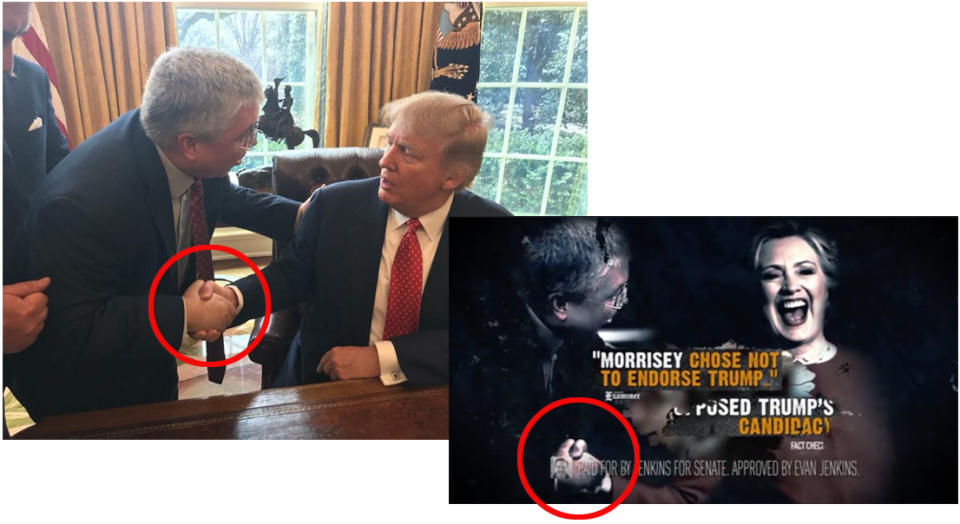West Virginia Senate candidate distorts reality in campaign ad
WASHINGTON — A Republican candidate for the U.S. Senate in West Virginia is running an ad showing his primary opponent shaking hands with Hillary Clinton — something that never happened. The ad uses a manipulated version of a photograph that originally showed his rival shaking the hand of someone else: President Trump.
Evan Jenkins, a congressman from West Virginia, is running in a six-candidate primary for the Republican nomination, with the winner set to take on Democratic incumbent Sen. Joe Manchin in the fall. The GOP primary is next Tuesday.
A recent ad from Jenkins’s campaign showed one of his Republican opponents, Attorney General Patrick Morrisey, genially greeting Clinton, the 2016 Democratic nominee for president. The image is a fake. But we only know that for sure because Jenkins spokesman Andy Sere told FactCheck.org that the Jenkins campaign had taken “creative license” with the ad.
“We sometimes take creative license while arranging images in order to help make a substantive point,” Sere said.

The FactCheck.org article mentioned that Morrisey’s campaign has run ads showing Jenkins and Clinton next to one another in a photo montage, a familiar visual device meant to link an opponent with an unpopular figure. But that is very different from manipulating a photo so that it purports to show a real event.
Jenkins’s ad is a step toward what the Atlantic magazine recently said could be “the collapse of reality,” as techniques for altering images become more realistic and harder to detect and spread from still photographs to video.
“When you and I look at the same object, how do you really know that we see the same thing?” wrote The Atlantic’s Franklin Foer. “Still, institutions (media, government, academia) have helped people coalesce around a consensus—rooted in a faith in reason and empiricism—about how to describe the world, albeit a fragile consensus that has been unraveling in recent years.”
Foer’s article explained how increasingly sophisticated technology will give bad actors the ability to create realistic-looking video that portrays people doing all sorts of things that they didn’t actually do.
This, Foer wrote, “will create new and understandable suspicions about everything we watch.”
It risks a further breakdown — beyond what we are already seeing in American public life — of a consensus on basic sets of facts about reality and truth. This kind of chaos opens doors to politicians who want to dismiss all criticism that comes their way as fake, much as the current president often does.
Joe Trippi, a Democratic consultant and ad-maker, confirmed that the Jenkins ad has pushed the envelope beyond where candidates have been willing to go.
“It’s pretty out there,” Trippi told Yahoo News.
In the past, Trippi said, ads have morphed the face of one politician into another, in part because ad-makers simply thought the technology was cool.
“It was clear what you were saying and doing: ‘He’s just another Ollie North Republican,’” Trippi said. “Now, though, we’re getting to this place where it’s not clear at all, and where with sleight of hand you can make events that didn’t happen actually appear as fact. And that’s a totally different thing.”
If the public does not punish politicians who engage in this kind of behavior, Trippi said, it will only continue and intensify.
“It’s a downward spiral,” he said. “Once the bad act starts to occur, sooner or later it degenerates into both sides doing it because it’s the only way to survive if voters are going to continue to respond to it. If it works, they’re going to keep doing it.”
Sere did not respond to a request for comment from Yahoo News.
Read more from Yahoo News:
As House wraps up Russia inquiry, top Dem on Senate probe says there’s no end in sight
After relief debacle, Puerto Rico’s governor looks for political revenge in Florida
After a week of diplomacy, an Iran deal still seems out of reach
What Mueller’s questions for Trump reveal about the investigation
Photos: A look back at the work of Shah Marai, AFP photojournalist killed in Kabul



